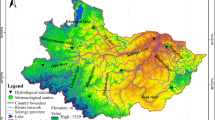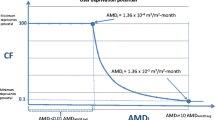Abstract
The present study carried out on the Ouémé delta in West Africa, addresses the implementation of the BBM approach for the determination e-flows in a context of high data limitation. It also highlights the potential challenges for the implementation of the recommended e-flows in West Africa countries. To do this, we first established the current ecological status of the delta based on data collection, measurements and scientists’ observations. Then, we formulated ecological objectives for e-flows based on the environmental management vision for the delta. And finally, we determined the water requirements for the sustainability of the biodiversity and ecosystem services using a simple 2D hydrodynamic model. The results indicate that 100 and 50% of the average natural flows are required respectively in low-water and high-water periods (3.4 billion m3 per year) to maintain the Ouémé Delta in its current environmental management class. This recommendation for e-flows allocation is in direct competition with the water requirements for the economic development of the delta, which is estimated to be over 3.0 billion m3 per year in the Master Plan for Water Development and Management. While it is clear that the establishment of e-flows recommendations must be accompanied by measures to limit the degradation of ecological habitats, it is even more clear that the economic development remained the main concern of policymakers. The integration of environmental flows into water resources management policies in developing countries requires linking water needs for economic development with water needs for the ecological sustainability of rivers and their associated ecosystems.




Similar content being viewed by others
References
Abahi KS, Gouissi MF, Akodogbo HH, Sanni Worogo SH, Adje ASDD, Gnohossou PM (2020) Assessment of the water quality of the upper reaches of the ouémé river in benin using benthic macroinvertebrate-based biotic indices. Rev des Sci de l’Eau 32(4):433–444
Adjakpa JB, Adjakpa WA, Lawouin L, Tossou J, Weesie PD, Akpo LE (2016) Spatio-temporal distribution and interannual variability of waterbirds of the lower valley of Ouémé in the south of Benin. J Anim Plant Sci 31(1):4874–4888
Arthington AH, Bhaduri A, Bunn SE, Jackson SE, Tharme RE, Tickner D, Young B, Acreman M, Baker N, Capon S, Horne AC (2018) The Brisbane declaration and global action agenda on environmental flows (2018). Front Environ Sci 6:45
Arthington AH, Land and Water Resources Research and Development Corporation, Arthington AH, Zalucki JM (1998) Comparative evaluation of environmental flow assessment techniques: review of methods. Land and Water Resources Research and Development Corporation, Canberra, p 141. Vol. 27
Bernhardt E, Bunn S, Hart DD, Malmqvist B, Muotka T, Naiman RJ, Pringle C, Reuss M, Wilgen BV (2006) Perspective: The challenge of ecologically sustainable water management. Water policy 8(5):475–479
Bhuiyan C (2022) Environmental flows: issues and gaps-a critical analysis. Sustainability Sci 17(3):1109–1128
Bradford MJ, Heinonen JS (2008) Low flows, instream flow needs and fish ecology in small streams. Can water Resour J 33(2):165–180
Declaration, B (2007) The Brisbane Declaration: environmental flows are essential for freshwater ecosystem health and human well-being. In 10th International River Symposium, Brisbane, Australia (pp. 3-6).
Degan BAS, Alamou EA, M’Po YNT, Afouda A (2018) Ouémé River Catchment SWAT Model at Bonou Outlet: Model Performance. Predictive Uncertain Multi-Site Valid Hydrol 6(2):61
Djihouessi MB, Degan A, Yekanbessoun NM, Sossou F, Adanguidi J, Aina MP (2022) Inventory of agroecosystem services and perceptions of potential implications due to climate change: A case study from Benin in West Africa. Environ Impact Assess Rev 95:106792
Djihouessi MB, Aina MP (2018) A review of hydrodynamics and water quality of Lake Nokoué: Current state of knowledge and prospects for further research. Regional Stud Mar Sci 18:57–67
Djihouessi MB (2018) Nutrient budget approach for the management of eutrophication and ecosystem services of Lake Nokoué. Doctoral dissertation, University of Abomey-Calavi, Benin
Djihouessi MB, Djihouessi MB, Aina MP (2019) A review of habitat and biodiversity research in Lake Nokoué, Benin Republic: Current state of knowledge and prospects for further research. Ecohydrol Hydrobiol 19(1):131–145
Djihouessi MB, Houngue R, Adandedji F, Sintondji L (2021) Toward the understanding of saline water intrusion and nutrient flushing in Lake Nokoué. EarthArxiv 1–13. https://doi.org/10.31223/X5105M
Essou GR, Brissette F (2013) Climate change impacts on the Oueme river, Benin, West Africa. J Earth Sci Clim Change 4(6):1
Houngue R (2020) Climate Change Impacts on Hydrodynamic Functioning of Oueme Delta (Benin). Doctoral dissertation, WASCAL, Benin
INE (2020) Diagnostic Analysis, Scenario and Vision. Plan Delta/EES study. National Water Institute, Benin
Jowett IG (1997) Instream flow methods: a comparison of approaches. Regulated Rivers: Res Manag: Int J Devoted River Res Manag 13(2):115–127
Kaboré I, Moog O, Ouéda A, Sendzimir J, Ouédraogo R, Guenda W, Melcher AH (2018) Developing reference criteria for the ecological status of West African rivers. Environ Monit Assess 190:1–17
King J, Louw D (1998) Instream flow assessments for regulated rivers in South Africa using the Building Block Methodology. Aquat Ecosyst Health Manag 1(2):109–124
King JM, Tharme RE, De Villiers MS (2008) Environmental Flow Assessments for Rivers: Manual for the Building Block Methodology; WRC Report No TT 354/08. Water Research Commission, Pretoria, South Africa
Kumar P (2010) The economics of ecosystems and biodiversity. Ecological and economic foundations [TEEB: The Economics of Ecosystems and Biodiversity]. Earthscan, London
Lawani RAN (2017) Characterization of Ouémé River Quality in Upper Delta Using Water Evaluation Indices and Multivariate Analysis. Eur Sci J 13(17):170–182
Le Barbé L, Alé G, Millet B, Texier H, Borel Y (1993) Surface water resources of the Republic of Benin. Monographies hydrologiques ORSTOM, (11).
MacKay HM (1999) Resource directed measures for protection of water resources. Institute for Water Quality Studies, Report No. N/0000_/REH0299, Department of Water Affairs and Forestry, Pretoria
N’Tcha M’Po Y, Lawin EA, Yao BK, Oyerinde GT, Attogouinon A, Afouda AA (2017) Decreasing past and mid-century rainfall indices over the Ouémé River Basin, Benin (West Africa). Climate 5(3):74
Neuenschwander P, Sinsin B, Goergen GE (2011) Nature conservation in West Africa: a red list for Benin. International Institute of Tropical Agriculture, Benin
Owusu AG, Mul M, van der Zaag P, Slinger J (2021) Re‐operating dams for environmental flows: From recommendation to practice. River Res Appl 37(2):176–186
Petts GE (1984) Impounded rivers: perspectives for ecological management. Wiley, Chichester
Poff NL, Matthews JH (2013) Environmental flows in the Anthropocence: past progress and future prospects. Current Opinion in Environmental Sustainability, 5(6):667–675
Poff NLR, Tharme RE, Arthington AH (2017) Evolution of environmental flows assessment science, principles, and methodologies. In: Water for the environment: from policy and science to implementation and management. Elsevier Inc., Amsterdam. https://doi.org/10.1016/B978-0-12-803907-6.00011-5
Prakasam C, Saravanan R (2023) Estimation of Environmental Flow Using Traditional Ecological Knowledge and Conservation of Fish Biodiversity. In Traditional Ecological Knowledge of Resource Management in Asia (pp. 303–316). Cham: Springer International Publishing.
Suen JP, Eheart JW (2006) Reservoir management to balance ecosystem and human needs: Incorporating the paradigm of the ecological flow regime. Water Resour Res 42:3
Sun T, Xu J, Yang Z (2012) Objective-based method for environmental flow assessment in estuaries and its application to the Yellow River Estuary, China. Estuaries coasts 35:892–903
Suwal N, Huang X, Kuriqi A, Chen Y, Pandey KP, Bhattarai KP (2020) Optimisation of cascade reservoir operation considering environmental flows for different environmental management classes. Renew Energy 158:453–464
Tennant DL (1976) Instream flow regimens for fish, wildlife, recreation and related environmental resources. Fisheries 1(4):6–10
Tharme RE (2003) A global perspective on environmental flow assessment: emerging trends in the development and application of environmental flow methodologies for rivers. River Res Appl 19(5‐6):397–441
Wineland SM, Bașağaoğlu H, Fleming J, Friedman J, Garza-Diaz L, Kellogg W, Koch J, Lane BA, Mirchi A, Nava LF, Neeson TM (2022) The environmental flows implementation challenge: Insights and recommendations across water-limited systems. Wiley Interdiscip Rev: Water 9(1):e1565
Zhao R, Yang ZF, Sun T, Chen B, Chen GQ (2009) Freshwater inflow requirements for the protection of the critical habitat and the drinking water sources in the Yangtze River Estuary, China. Commun Nonlinear Sci Numer Simul 14(5):2507–2518
Acknowledgements
Special thanks to Professor Michael McClain and Lauren Zielinski from from IHE-Delft, Netherlands for participating to the focus groups meetings between stakeholders and to the the training of local governmental experts about environmental flows assessments principles.
Author contributions
MBD, FS, and BMD wrote the main manuscript text. BASD and RHcompleted all the hydrological and hydraulic analysis. They also participate to data collection. MD, GD, OHO, LH, TOL conducted field works and data collection on biodiversity. They also reviewed part of the manuscript. BAT and ARF organized the data and prepared the figures. MPA reviewed the whole manuscript.
Funding
Metogbe Belfrid Djihouessi received a grant from International Foundation for Science (IFS Grant W 5840-2). This funding contributed for Field campaigns and instrumentation. Thanks to the Shared Resources, Joint Solutions (SRJS) program and the Benin Environment and Education Society for funding some of the additional data collection work.
Author information
Authors and Affiliations
Corresponding author
Ethics declarations
Conflict of interest
The authors declare that they have no known conflict of interests or personal relationships that could have appeared to influence the work reported in this paper. The authors declare the following financial interests/personal relationships which may be considered as potential conflict of interests.
Additional information
Publisher’s note Springer Nature remains neutral with regard to jurisdictional claims in published maps and institutional affiliations.
Supplementary information
Rights and permissions
Springer Nature or its licensor (e.g. a society or other partner) holds exclusive rights to this article under a publishing agreement with the author(s) or other rightsholder(s); author self-archiving of the accepted manuscript version of this article is solely governed by the terms of such publishing agreement and applicable law.
About this article
Cite this article
Djihouessi, M.B., Sossa, F., Djihouessi, B.M. et al. Environmental Flows Assessment Based on the Coupling of Water Level and Salinity Requirements for Maintaining Biodiversity: A Case Study from the Ouémé delta in West Africa. Environmental Management 73, 115–129 (2024). https://doi.org/10.1007/s00267-023-01899-6
Received:
Accepted:
Published:
Issue Date:
DOI: https://doi.org/10.1007/s00267-023-01899-6




